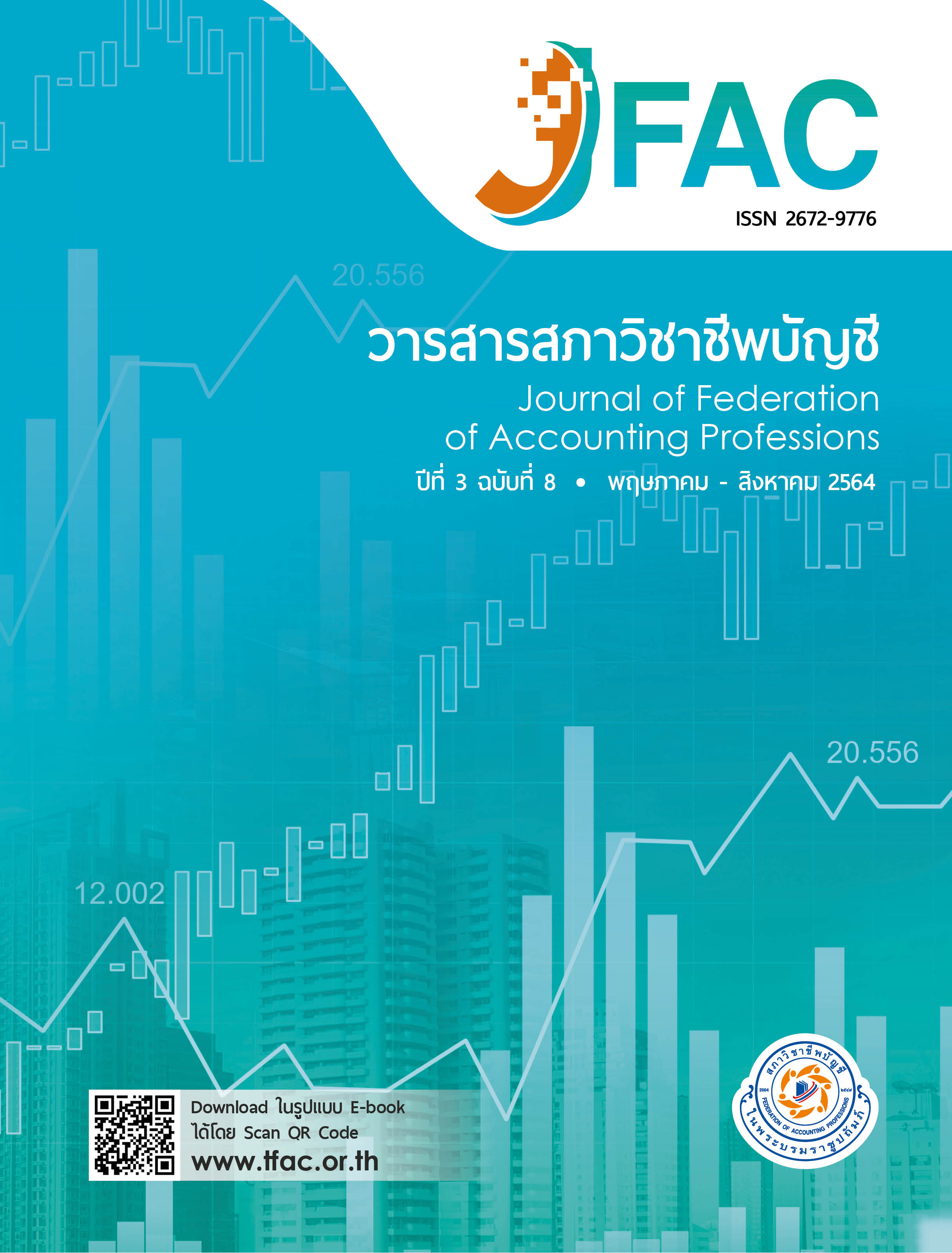บริษัทที่มีข้อจำกัดทางการเงินสามารถเข้าถึงแหล่งเงินทุนจากภายนอกหรือไม่? : ผลกระทบของการตั้งราคาหลักทรัพย์ผิดพลาดต่อการตัดสินใจทางด้านการจัดหาเงินและการลงทุนขององค์กร
Main Article Content
บทคัดย่อ
บทความวิชาการนี้มีวัตถุประสงค์ เพื่อศึกษาผลกระทบของการประเมินมูลค่าหลักทรัพย์ผิดพลาดต่อการตัดสินใจขององค์กร โดยเฉพาะการตัดสินใจทางด้านการจัดหาเงินจากแหล่งภายนอกและการลงทุนขององค์กร การประเมินมูลค่าหลักทรัพย์ผิดพลาดเกิดขึ้นเมื่อราคาของหลักทรัพย์สูงกว่าหรือต่ำกว่ามูลค่าที่แท้จริง ความแตกต่างของราคาเกิดขึ้นจากการประเมินราคาที่ผิดพลาดของนักลงทุนซึ่งได้รับข้อมูลของหลักทรัพย์ไม่เพียงพอ วรรณกรรมที่เกี่ยวข้องได้มีการศึกษาว่าการประเมินมูลค่าหลักทรัพย์ผิดพลาดส่งผลกระทบต่อกิจกรรมทางธุรกิจ โดยเฉพาะทางด้านการลงทุนและทางจัดหาเงินจากแหล่งภายนอกของบริษัท นอกจากนี้บทความวิชาการนี้ยังอภิปรายว่าการประเมินมูลค่าหลักทรัพย์ผิดพลาดส่งผลกระทบเชิงบวกต่อบริษัทที่มีข้อจำกัดทางการเงินอย่างไร เนื่องจากบริษัทที่มีข้อจำกัดทางการเงินต้องเผชิญกับต้นทุนในการทำธุรกรรมและต้นทุนตัวแทนที่สูงกว่าบริษัทที่ไม่มีข้อจำกัดทางการเงินในการระดมทุนในตลาดหลักทรัพย์ บทความวิชาการนี้จึงได้อภิปรายถึงโอกาสที่ผู้บริหารของบริษัทที่มีข้อจำกัดทางการเงินในการใช้บัญชีคงค้างเพื่อนำไปสู่การตัดสินใจในการลงทุนในหลักทรัพย์ของบริษัทดังกล่าวจากนักลงทุน
Article Details
เนื้อหาและข้อมูลในบทความที่ลงตีพิมพ์ในวารสารสภาวิชาชีพบัญชี ถือเป็นข้อคิดเห็นและความรับผิดชอบของผู้เขียนบทความโดยตรงซึ่งกองบรรณาธิการวารสารไม่จำเป็นต้องเห็นด้วยหรือร่วมรับผิดชอบใด ๆ
บทความ ข้อมูล เนื้อหา รูปภาพ ฯลฯ ที่ได้รับการตีพิมพ์ในวารสารสภาวิชาชีพบัญชี ถือเป็นลิขสิทธิ์ของวารสารสภาวิชาชีพบัญชี หากบุคคลหรือหน่วยงานใดต้องการนำข้อมูลทั้งหมดหรือบางส่วนไปเผยแพร่ต่อหรือเพื่อกระทำการใดๆ จะต้องได้รับอนุญาตเป็นลายลักษณ์อักษรจากวารสารสภาวิชาชีพบัญชี ก่อนเท่านั้น
เอกสารอ้างอิง
Badertscher, B. A., Shanthikumar, D. M., & Teoh, S. H. (2019). Private firm investment and public peer misvaluation. The Accounting Review, 94(6), 31-60.
Bradshaw, M. T., Richardson, S. A., & Sloan, R. G. (2001). Do analysts and auditors use information in accruals? Journal of Accounting Research, 39(1), 45-74.
Campello, M., & Graham, J. R. (2013). Do stock prices influence corporate decisions? Evidence from the technology bubble. Journal of Financial Economics, 107(1), 89-110.
Chang, X., Dasgupta, S., & Wong, G. (2011). How do firms allocate internal cash flow? The effect of misvaluation and costly external financing. SSRN Electronic Journal.
Dong, M., Hirshleifer, D., & Teoh, S. H. (2020). Misvaluation and corporate inventiveness. Journal of Financial and Quantitative Analysis, 1-29.
Farre-Mensa, J., & Ljungqvist, A. (2015). Do measures of financial constraints measure financial constraints? Review of Financial Studies, 29(2), 271-308.
Fazzari, S. M., Hubbard, R. G., Petersen, B. C., Blinder, A. S., & Poterba, J. M. (1988). Financing constraints and corporate investment. Brookings Papers on Economic Activity, 1988(1), 141.
Hadlock, C. J., & Pierce, J. R. (2010). New evidence on measuring financial constraints: moving beyond the KZ index. Review of Financial Studies, 23(5), 1909-1940.
Jones, J. J. (1991). Earnings management during import relief investigations. Journal of Accounting Research, 29(2), 193.
Kaplan, S. N., & Zingales, L. (1997). Do investment-cash flow sensitivities provide useful measures of financing constraints? The Quarterly Journal of Economics, 112(1), 169- 215.
Keynes, J. M. (1942). The general theory of employment, interest and money. MacMillan.
Kurt, Ahmet C. (2013). Essays on corporate financial reporting (Unpublished doctoral dissertation). University of Pittsburgh, Pittsburgh, Pennsylvania.
Linck, J. S., Netter, J., & Shu, T. (2013). Can managers use discretionary accruals to ease financial constraints? Evidence from discretionary accruals prior to investment. The Accounting Review, 88(6), 2117-2143.
Polk, C., & Sapienza, P. (2008). The stock market and corporate investment: A test of catering theory. Review of Financial Studies, 22(1), 187-217.
Shen, H., Zheng, S., Xiong, H., Tang, W., Dou, J., & Silverman, H. (2021). Stock market mispricing and firm innovation based on path analysis. Economic Modelling, 95, 330-343.
Sloan, R. G. (1996). Do stock prices fully reflect information in accruals and cash flows about future earnings? Accounting Review, 71(3), 289-315.
Subramanyam, K. (1996). The pricing of discretionary accruals. Journal of Accounting and Economics, 22(1-3), 249-281.
Teoh, S. H., Welch, I., & Wong, T. (1998). Earnings management and the underperformance of seasoned equity offerings. Journal of Financial Economics, 50(1), 63-99.
Whited, T. M., & Wu, G. (2006). Financial constraints risk. Review of Financial Studies, 19(2), 531-559.
Xie, H. (2001). The mispricing of abnormal accruals. The Accounting Review, 76(3), 357-373.


